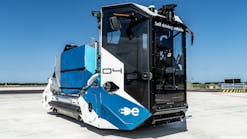Warrenton, Ore. --- LEKTRO ushered in its 70th Anniversary with a series of events for its customers, current and former employees, their families, vendors and friends. Customers flew in from all over the country to attend the highly anticipated event which had about 650 attendees last weekend.
2015 marks a milestone for the electric aircraft vehicle manufacturer. In 2015, LEKTRO took their global leadership of the industry to a new level with two new airline contracts and several certifications from major aircraft OEMs to tow their aircraft.
“Of 70 years in business, 67 were at the Astoria-Warrenton Regional Airport in Clatsop County,” said Henry Balensifer, LEKTRO’s Communications Manager. “We wanted to share this beautiful place we call home with our customers and commemorate the hard work of our current and former employees.”
The events ranged from salmon fishing charters and sightseeing tours, to a main event at the county fairgrounds which included obstacle courses, a game show and a static display of legacy electric vehicles LEKTRO used to manufacture as well as the newest vehicles in current production. The main event was capped off with a concert by country music star Phil Vassar.
Humble Beginnings
In 1945, Wilt and Violet Paulson founded Willamette Aircraft and Engine Company in Beaverton, Oregon, to repurpose military aircraft for crop dusting and other civilian uses. Moving their company to the coastal town of Warrenton, Oregon, in 1948 to be closer to family, their business quickly morphed into the electric vehicle company now known as LEKTRO.
Under Wilt’s creative genius, LEKTRO developed products for the logging, farming, golf, material handling, newspaper, theme park and aviation industries. Some of these inventions were the first of their kind, including the first portable wind machine for logging slash burns, the first battery powered vehicle to feed mink, one of the first golf carts, and the first towbarless aircraft tug. The last of which revolutionized aircraft towing.
The first towbarless aircraft tug was conceived by Wilt and his friend Sy King, who founded Flightcraft in Portland, now an Atlantic Aviation company. Sy thought that if there was a way to eliminate the towbar and simply lift the nose landing gear aircraft would be spared damage that was otherwise common. They developed the “Airporter” together by turning the LEKTRO mink feeder chassis around so that the steer tires were at the rear of the vehicle, under the operator, and the drive tires at the front, where a hydraulic lift cradle would be attached. The cradle would then raise the nose gear of the aircraft off the ground, transferring the aircraft nose weight onto the tug. This was the world’s first towbarless aircraft tug.
LEKTRO also produced several other vehicles in addition to what it invented over the years such as: custom warehouse vehicles, parade chassis and forklifts. Unfortunately, many of Wilt’s inventions were not protected and LEKTRO was not large enough to mass produce. As a result, larger companies began producing their versions of Wilt’s inventions and overtook the market.
Second Generation Takes the Helm
During the early 1980s, Wilt’s health began to suffer and LEKTRO’s finances were impacted by the recession. His son Eric Paulson, then a sophomore in college, left his studies in 1982 to run the company while his father recovered. In 1985, Eric became president of LEKTRO and assumed ownership. Through skillful negotiations and strategic planning, Eric was able to turn the company around and has since focused the company on electric towbarless aircraft tugs, where it has remained the leader in the industry. “We had seen larger companies take our inventions and beat us out of the market, but there was one invention we could still take leadership with and that was the towbarless tug,” LEKTRO President Eric Paulson commented.
Over the years, LEKTRO continued to improve the original “Airporter” design and unveiled several improved models and chassis series. One of the most revolutionary series, the AP8800, was developed with feedback from Gulfstream. Its low profile enabled it to move large corporate jets from underneath the fuselage, making it easier to stack cramped hangars.
Over nine different model series have been introduced since the first Airporter, with countless variations within those series. One thing remains constant with its towbarless tugs: they have always been electric.
“LEKTRO’s product line has been all-electric before electric vehicles were cool,” Balensifer added.
LEKTRO was more recently able, through a recent and aggressive OEM certification campaign, to certify its largest model, the AP8950SDB-AL-200, on all the A320 and B737 aircraft families down through regional aircraft. This has made it the most versatile airline tug in the world.
Success
Among many things, LEKTRO tugs are most known for their reliability and the company’s product support. “I’m not sure many manufacturers as old as we are can say their second tug ever made, is still in operation. Ours is, at an FBO in Ashland, Oregon,” Balensifer commented. “That LEKTRO is 48 years old.”
The company’s first unit was in service at Flightcraft until it was traded in for a newer unit so it could become part of LEKTRO’s museum. There are now nearly 5,000 LEKTRO tugs in operation in nearly every country of the world.
LEKTRO attributes part of its success to its single-family ownership as well.
“We don’t answer to shareholders and we don’t cut corners,” Balensifer noted.





